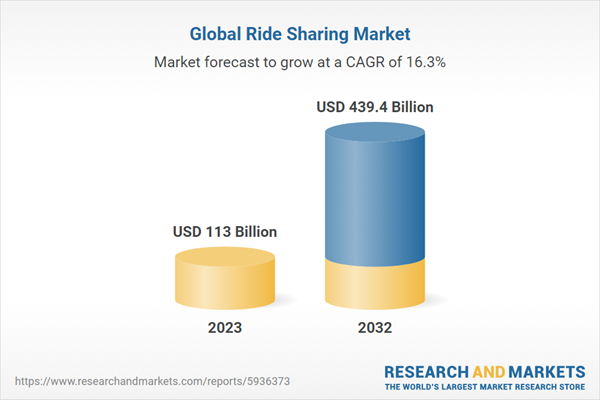Ride sharing refers to a transportation model where individuals share a vehicle trip, reducing travel costs, congestion, and environmental impact. This concept contrasts with traditional taxi services by enabling regular people to turn their private vehicles into part-time taxis through a digital platform. These platforms, typically smartphone applications, match passengers with drivers heading in the same direction. Ride sharing has gained significant traction due to its convenience, cost-effectiveness, and the rise of smartphones and mobile internet access. Market players offer a range of services from economical carpool options to more luxurious solo rides. The model's scalability has enabled rapid expansion into global markets, appealing to urban residents, commuters, and those without access to private or public transportation. The growth of ride sharing has been accompanied by regulatory challenges and concerns over safety, employment status of drivers, and its impact on traditional taxi services. Despite these issues, ride sharing remains an integral part of the evolving urban transportation landscape, offering a flexible alternative to conventional transport modes.
Ride Sharing Market Trends
Technological advancements, particularly in smartphone technology and mobile internet connectivity, represent one of the key factors driving the global ride sharing market. The widespread adoption of smartphones has facilitated the growth of app-based ride sharing platforms, allowing for real-time matching of drivers and passengers. GPS technology ensures efficient route planning, while digital payment systems enable seamless financial transactions. Additionally, developments in data analytics has helped these platforms optimize pricing and logistics, enhancing user experience. Economically, ride sharing offers cost savings for users, as it typically undercuts traditional taxi fares and reduces the need for personal vehicle ownership, especially in urban areas where parking and maintenance costs are high. This economic efficiency is particularly appealing in the context of growing urbanization and the increasing economic pressure on urban residents.Social and environmental factors are also significantly contributing to the growth of the ride sharing market. There is a rising awareness of environmental issues, and ride sharing is seen as a more sustainable transportation option. By maximizing vehicle occupancy, it reduces carbon emissions and traffic congestion, aligning with broader environmental goals. Furthermore, changing social attitudes, especially among younger populations, favor access over ownership, leading to a greater acceptance of shared services. This shift is part of a larger trend towards a 'sharing economy,' where assets and services are shared between individuals, often facilitated by technology. Ride sharing also addresses gaps in existing public transportation networks, providing a flexible solution for last-mile connectivity. However, the industry faces challenges, including regulatory hurdles, concerns over the safety and rights of both drivers and passengers, and the impact on traditional taxi services. These issues, alongside the potential disruption from autonomous vehicle technology, represent ongoing considerations for the future trajectory of the ride sharing market.
Key Market Segmentation:
The report provides an analysis of the key trends in each segment of the market, along with forecasts at the global, regional, and country levels for 2023-2032. The report has categorized the market based on service type, booking mode, membership type, and commute type.Service Type Insights:
- E-Hailing
- Car Sharing
- Station-Based Mobility
- Car Rental
Booking Mode Insights:
- App-based
- Web-based
Membership Type Insights:
- Fixed Ridesharing
- Dynamic Ridesharing
- Corporate Ridesharing
Commute Type Insights:
- ICE Vehicle
- Electric Vehicle
- CNG/LPG Vehicle
- Micro Mobility Vehicle
Regional Insights:
- North America
- United States
- Canada
- Asia-Pacific
- China
- Japan
- India
- South Korea
- Australia
- Indonesia
- Others
- Europe
- Germany
- France
- United Kingdom
- Italy
- Spain
- Russia
- Others
- Latin America
- Brazil
- Mexico
- Others
- Middle East and Africa
Competitive Landscape
The report has also provided a comprehensive analysis of the competitive landscape in the global ride sharing market. The detailed profiles of all major companies have been provided. Some of the companies covered include ANI Technologies Pvt. Ltd. (OLA), BlaBlaCar, Bolt Technology OU, Cabify, Curb Mobility LLC, Gett, Grab Holdings Inc, HyreCar Inc, Lyft, Inc., Tomtom International B.V., and Uber Technologies Inc.Key Questions Answered in This Report:
- How has the global ride sharing market performed so far, and how will it perform in the coming years?
- What are the drivers, restraints, and opportunities in the global ride sharing market?
- What is the impact of each driver, restraint, and opportunity on the global ride sharing market?
- What are the key regional markets?
- Which countries represent the most attractive ride sharing market?
- What is the breakup of the market based on the service type?
- Which is the most attractive service type in the ride sharing market?
- What is the breakup of the market based on the booking mode?
- Which is the most attractive booking mode in the ride sharing market?
- What is the breakup of the market based on the membership type?
- Which is the most attractive membership type in the ride sharing market?
- What is the breakup of the market based on the commute type?
- Which is the most attractive commute type in the ride sharing market?
- What is the competitive structure of the global ride sharing market?
- Who are the key players/companies in the global ride sharing market?
Table of Contents
Companies Mentioned
- ANI Technologies Pvt. Ltd. (OLA)
- BlaBlaCar
- Bolt Technology OU
- Cabify
- Curb Mobility LLC
- Gett
- Grab Holdings Inc
- HyreCar Inc
- Lyft Inc.
- Tomtom International B.V.
- Uber Technologies Inc.
Methodology

LOADING...
Table Information
| Report Attribute | Details |
|---|---|
| No. of Pages | 140 |
| Published | January 2024 |
| Forecast Period | 2023 - 2032 |
| Estimated Market Value ( USD | $ 113 Billion |
| Forecasted Market Value ( USD | $ 439.4 Billion |
| Compound Annual Growth Rate | 16.2% |
| Regions Covered | Global |
| No. of Companies Mentioned | 11 |









